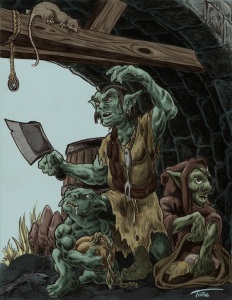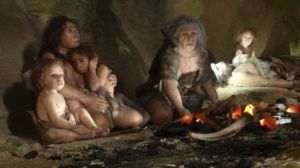Goblins go way back in the mythologies of just about every recorded civilization, trolls mainly from Norse mythology, but both generally being depicted as deformed humanoids that loiter underground, under bridges, in dark caves and always in our peripheral imaginations. Thanks to a myriad of computer games and wizardly films, they’re more a firm part of our modern consciousness than ever. If any child of the western world were asked to whip up an image of either, their sketches might look something like this:


The weight and body build varies, as does the extent of the physical affliction – e.g. the apparent scoliosis of the fellow on the right – but endemic features are the long pointy ears and nose, jaggedy or irregular teeth, enlarged feet and hands and a heavy brow.
Their skin is greenish in hue and their clothes generally portrayed as Medieval. And, as depicted in this scene from ‘Dead Queens of Morvena’, goblins are usually perceived to be savage and gluttonous.

Whereas the troll might look something like this:



Trolls vary in size, some depicted as gigantic; smaller versions tend to be in toy form or are the friendlier versions of children’s stories.
Not unlike the goblin, common features include a greenish complexion, large nose, ears, feet and hands, but the troll is chunkier and strangely, is often shown to have vegetation, even trees, sprouting from his person. He is often drawn carrying a huge club or axe, a warning of savagery and aggression, not dissimilar to the ogres of more widespread mythology.
Ogres are, again, humanoid creatures like the goblin and the troll, and are also generally shown as being stooped and deformed, particularly around the head and neck.
The belief that clearly separates the ogre, though, is that this hideous giant eats human flesh, with a particular liking for the taste of human babies.

Kwakiutl pole representing the cannibal ogress Dzonoqwa
 Hop-o-My-Thumbs Ogre
Hop-o-My-Thumbs Ogre
But where did these beings spring from, to take root in our eternal imaginations?
The goblin has roots in the mythology of many ancient civilizations around the globe, whereas the troll is known to have evolved in Scandinavian countries preceding Christianity. However, depictions of trolls and ogres have many resemblances, not only in appearance, but in nature: the aggression in the toting of a huge club, and most importantly, in the implied threat to humankind.
So, here’s a thought:
Though some modern scientists argue that Neanderthal man, our closest evolutionary cousin, may not have been wiped out by the Homo-sapien (human being) – that climate change may at least have contributed to their swift decline – there would no doubt have been cause for conflict between the two emerging species in times of co-existence. Research shows that Homo-sapiens came out of Africa with ten times the population of Neanderthals, quickly ‘overrunning’ their hunting territories and driving them into smaller, more barren areas.


Source: Daily Mail (Does the stooped upper body, barrel-torso, large nose and heavy brow remind you of any of the other pictures in this article?)
Though only comparable in height to Homo-sapiens, Neanderthals are believed to have been much stronger than modern humans. Being far chunkier and having much stronger arms and larger hands no doubt afforded them certain advantages and must have rendered them fearsome to look at. Quartz hand-axes, three-sided picks, and stone cleavers are known to be among the tools that they used for hunting and fighting. Head wounds found on fossils are evidence of inflicted violence.
Is it possible then, given the extreme hardship caused by the onslaught of man, that the Neanderthal race stooped to opportunistic cannibalism? (Fee-fi-fo-fum: The ground up bones of animals are known to have been part of the Neanderthol diet). Is this where our fear of baby-eating-ogres sprang from? Or was it vice versa? There is more evidence to suggest this, as necklaces comprised of the teeth of Neanderthals have been discovered in Homo-sapien sites:
http://www.dailymail.co.uk/sciencetech/article-2333449/Did-eat-Neanderthals-Dramatic-new-theory-claims-devoured-early-man.html
Were Homo-sapiens the true aggressors, acting out of fear of something different, as indeed we still do to this day? Then exploiting their advantage, as we still do today? Were tales of giants, or ogres, an early warning to Homo-sapien children to beware the stranger, the one who is different, the thick- set, heavy browed, thuggish looking one in this case? Exaggerated messages and imagery not that different to those anti-Semitic ones put out by the Third Reich before their extermination of the Jews in Germany.

Source: forums.station.sony.com
Could it be that our very first genocide as a species lives on in our consciousness in the form of goblins, trolls and ogres? If so, perhaps their image is imprinted on our minds, and will be until the end of our earthly reign.

In the newly released horror novel, Damned Rite: MELT, I capitalize on the enduring human fear of such unusual statures in a strange and fearsome character named Hexter, a monk persecuted for his apish appearance, to the point where his own potential for violence is born, ultimately to the peril of a world that hounded him.
http://www.amazon.com/dp/B00QVLEQJ8
Follow me at: https://twitter.com/wood_melt
Friend me at: https://www.facebook.com/janinelangley.wood
Visit my website at: http://janinewood2012.wix.com/janine-langleywood
Book website: http://janinewood2012.wix.com/melt—horror-novel
